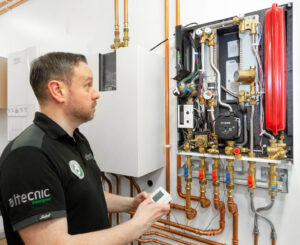What is a HIU? - The Facts & Benefits of Heat Interface Units
What is a HIU? Firstly, it is important to get a handle on the wider picture and understand where you will find HIUs and the larger systems they operate within.
What is a heat network?
A heat network sometimes referred to as district heating, is a system that uses a centralised heat source (usually located in a plant/mechanical/boiler room) to distribute hot water through a network of insulated pipes. This system is generally used to fulfil heating and hot water requirements in residential buildings such as apartment complexes but is also used in educational and commercial buildings. HIUs are used to transfer heat from this centralised source to each individual dwelling.
What is a HIU?
Heat Interface Units (HIUs) are similar in appearance to a standard boiler and are typically used in the heat networks explained above. They act as a bridge between the central boiler and the hot water outlets in each apartment such as radiators, showers, kitchen taps, etc. This removes the need to install individual boilers in each dwelling, creating both money-saving and energy-saving opportunities amongst many other benefits.

Altecnic SATK32 HIU
How does a HIU work?
HIUs are installed into each property in the building as a boiler would be. The unit is connected to one central boiler through a network of pipes. HIUs like the ones manufactured by Altecnic incorporate one or two-plate heat exchangers to transfer the heat from the central system into instantaneous heating and hot water as and when it is required.
Altecnic HIUs incorporate an internal electronic control unit that ensures maximum efficiency, improved reaction time and control, but also incorporates other additional features. Modulating valves control the supply of hot water to both the space heating and domestic hot water within the apartment. The thermally insulated casings also minimise heat loss from the unit.
Benefits of using HIUs
When compared to traditional individual heating systems, HIUs present greater benefits to both landlords and tenants. When used with centralised heating systems, heat interface units can have the following advantages:
Minimised installation and maintenance
- As maintenance and repair are focussed on the central plant room as opposed to individual boilers in each dwelling, long-term cost savings can be achieved.
- Installing boilers in each property would be costly, labour-intensive and time-consuming. Installing an HIU is much more cost-effective.
- The maintenance of an HIU is more straightforward compared to a gas boiler, with all components located inside the box for the engineer.
Compliance with low-carbon and renewable energy requirements
- Although central gas boilers are used, heat networks also present a great opportunity to use renewable energy sources such as CHP, biomass, solar or heat pumps.
- As the system delivers hot water on demand, no energy is wasted from heat building up or dissipation after use.
*Maximum energy savings from the HIUs can only be achieved if the system is designed, installed, and commissioned correctly, and HIUs are selected and sized correctly.
Space-saving
- HIUs take up much less space than a boiler, meaning available floorspace is optimised in each property.
Benefits for the consumer
- HIUs are very responsive, providing instant supply on-demand
- Energy bills should be decreased as communal heating is all about improving energy efficiency, CO2 reduction and saving on running costs.
- Eliminating the gas supply alleviates any worries about carbon monoxide emissions.
- Occupants have good visibility of energy consumption which promotes energy saving.
